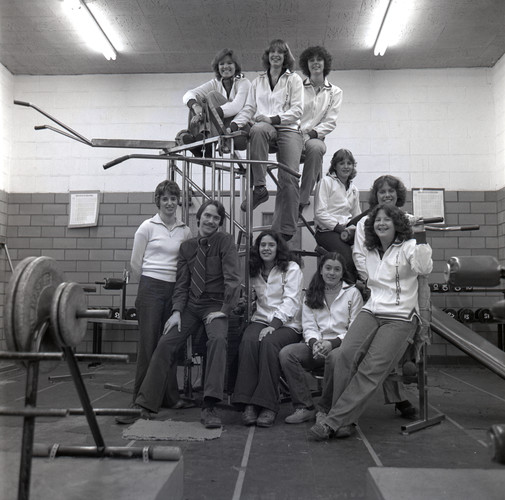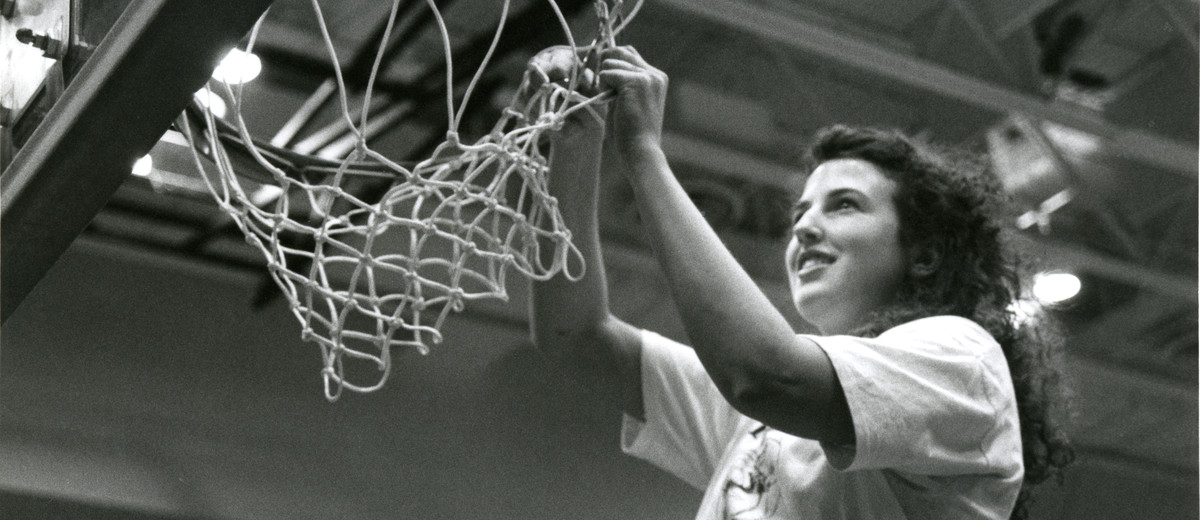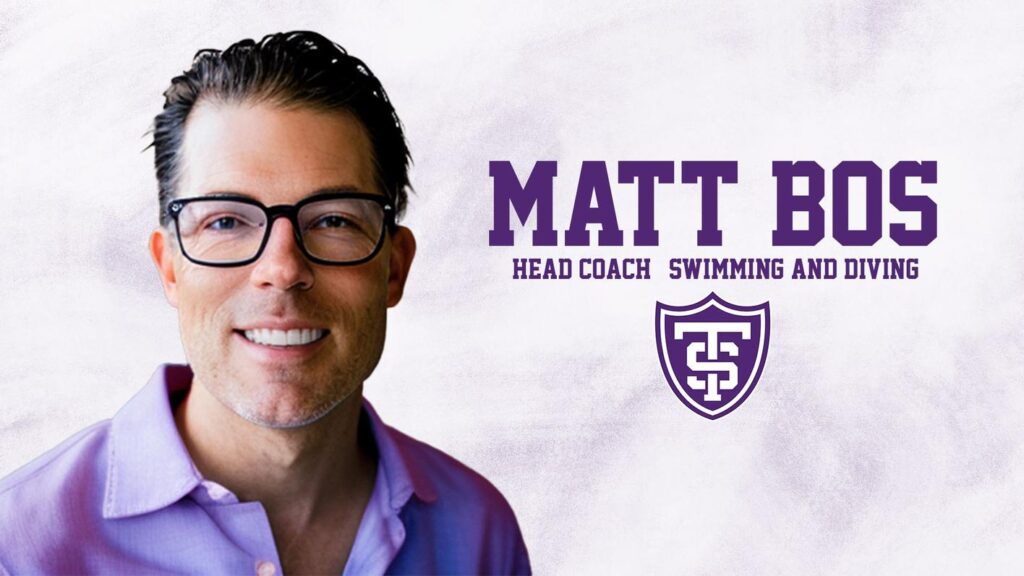“No person in the United States Shall, on the basis of sex, be excluded from participation in, be denied the benefits of, or be subjected to discrimination under any educational program or activity receiving federal financial assistance.”
With this brief sentence, Title IX reshaped the landscape of women’s athletics and, more recently, has become the cornerstone of President Barack Obama’s fight against sexual harassment and violence on college campuses.
St. Thomas has remained committed to staying ahead of changes Title IX has inspired – not only for the sake of complying with the law, but as Emily Erickson, the campus’ new sexual misconduct prevention coordinator, put it, because “there’s this deep thread of care and concern for people’s dignity and their ability to feel safe, comfortable and welcome in the community.”
Welcoming women on campus
Following Title IX’s passage, universities struggled to understand, and sometimes fought against, how Title IX impacted their athletics departments.
St. Thomas, an all-male institution until fall 1977, faced a different issue: When women stepped on campus for the first time that September, the college not only had to handle sports, but every aspect of going coeducational. While many universities altered antiquated sports models, St. Thomas’ entire campus was transforming.
The changes were pronounced more outside the classroom, as St. Catherine students already had been attending classes. The oddity of female presence was felt most in the dining room, the residence halls, clubs and sports.
Eight sports were fielded for women: cross country, track, softball, volleyball, tennis, basketball, swimming and golf. JoAnn Andregg, as the new women’s volleyball and tennis coach, said she was aware of the curiosity directed toward women. But more importantly, she said she felt women and women athletics were accepted as equal partners from day one.
She and Steve Fritz ’71, the current athletic director, largely attributed that to then-athletic director Frank Mach ’55.
“He only knew the men’s model. ... He took what he knew, and said, ‘This is how the women are going to do it too,’” Andregg said.
John Wendt, professor of ethics and business law, who has an extensive background in sports law, including being named to Minnesota Amateur Sports Commission by Gov. Mark Dayton in 2013, said support from the administration and leadership from individuals such as Andregg and Fritz couldn’t be overstated.
“They’ve taken such incredible leadership to ensure gender equity, to promote a balance of academics and athletics,” Wendt said. “That, to me, has been remarkable and is leadership at its fundamentals.”
The Athletics Department faced many of the same challenges as the rest of campus, including renovating old buildings intended for an all-male school. The college created restrooms and locker rooms for both sexes, and sometimes had to reformat the flow of a building.
“We had to make a lot of new spaces and had to make some spaces that already existed work for both genders. But really, that was campuswide,” Fritz said.

The women's tennis team in 1978.
Minor stumbling points occurred as the department adjusted: The volleyball team started in old men’s soccer and basketball uniforms, according to a 1978 issue of The Aquin, and the women’s tennis team had no budget the first year because the program was approved after budgets were set.
Cathy Bremer Lombritto ’81, who swam, golfed and later coached at St. Thomas, said the transition was still “seamless.”
“We never had any excuses thrown at us,” Bremer Lombritto said. “They put the teams out there and built as they could and let the teams grow.”
Andregg pointed out how quickly women’s sports achieved success. In 1981, women’s cross country won a national championship with the Association for Intercollegiate Athletics for Women (AIAW), which provided championships for women before the National Collegiate Athletic Association (NCAA).
“It was an amazing and phenomenal thing. In only four years, women brought a national championship,” Andregg said. “I am proud we have one of the few national championships (with the AIWA). Not a lot of schools can go over to their trophy case and see that.”
Debra Thometz Leyden ’83, one of the first women added to the St. Thomas Athletic Hall of Fame in 1989, won the individual cross country championship in 1981. She echoed Andregg, saying St. Thomas strove to meet the needs of the women’s teams.
“That it wasn’t apparent the school had been coed for only a few years really said a lot,” Thometz Leyden said. “Girls wanted to come to St. Thomas because of the success of the program.”
Title IX in sports today
Being a Division III school makes a difference, according to Wendt, especially when it comes to money and scholarships, which bring additional issues for Division I.
At this level, Wendt said schools focus on providing a quality program that benefits the entire individual, a mentality he attributed to the success of women’s athletics and the strength of the Athletics Department.
“Here, especially in academics and athletics, you’re part of the St. Thomas family,” Wendt said. “That’s a cultural thing here. You want people to succeed.”
When it comes to sports, budgets are the easiest way to go afoul of Title IX, Wendt, Andregg and Fritz all agree.
“If a donor came to you and said, ‘I want to build you a new baseball field,’ the athletic director would have to say, ‘Well, wait a minute, we have a softball team here,’” Andregg said. “You couldn’t just let gifts go in one direction. Gifts had to be spread between both genders.”
With a much wider pool of male alumni, Andregg said St. Thomas has been vigilant about fundraising.
While Wendt pointed out a still-existing gap between opportunities for men and women in school, Title IX has resulted in more overall opportunities for women.
“What would have happened if I was five to seven years older?” Bremer Lombritto said. “I really wonder what it would be like if Title IX had come along later. I know a number of opportunities would have been different for me.”

Softball in 1978.
A new focus
Within the last decade, the emphasis has fallen away from athletics and new issues have stepped into the spotlight: sexual harassment and violence. In 2014 in particular, the federal government gave new strength to Title IX: Vice President Joe Biden headed up the White House Task Force to Protect Students from Sexual Assault; the White House launched the #itsonus campaign, which encourages bystander intervention, particularly from men; and the U.S. Department of Education’s Office for Civil Rights began publishing lists of colleges with Title IX investigations for possible violations in handling sexual violence and harassment complaints.
As with athletics, St. Thomas is committed to being at the forefront. In 2011, St. Thomas began reviewing its sexual misconduct policy, which was approved in summer 2014. With federal developments in mind, the new policy was intended to clarify, educate and prevent sexual misconduct. Revising the policy, much as Title IX is enforced on campus, was done by a variety of people spread across the university.
Human Resources, General Counsel and the Dean of Students Office play integral roles in supporting Title IX compliance. Nora Fitzpatrick, who served as the interim Title IX director, said having a decentralized structure infuses Title IX throughout the organization.
“It really sends the message that it’s everybody’s business to ensure we have a safe campus,” Fitzpatrick said.
Clarity and transparency
Rachel Harris, associate dean of students, said clarity and transparency were key when revising the policy. The policy now provides definitions for situations the Dean of Students Office had dealt with but weren’t defined specifically, such as stalking, dating violence and domestic violence.
Having clear definitions for sexual assault and consent is vital; not having those definitions makes it easy for schools to run into trouble with Title IX. Associate general counsel Abigail Crouse, who provides legal guidance regarding Title IX, said they examined state law regarding criminal activity and also other institutions’ policies, but ultimately looked to create definitions easy for students to understand and that fit St. Thomas standards.
St. Thomas has had an affirmative consent policy for approximately 10 years. Such a policy means actively gaining a “yes” before participating in sexual activity, instead of assuming a lack of a “no” is consent.
“Instead of asking, ‘How did you say no? How did you resist?’ now we put the burden on the person being accused: ‘How did you get permission? What was said or done that means the sexual activity was consensual?’ It really shifts how we think about and how we make decisions about sexual misconduct and sexual assault,” Harris said.
Erickson said an affirmative consent policy fits better with the definition of consent.
“You would never borrow someone’s car without their permission or use their desk or textbook without their permission,” Erickson said. “Of course we should ask for permission to get an affirmative yes when we’re doing something as intimate as being sexual with someone.”
For the goal of transparency, face-to-face training was done. Students need to know available resources and what the procedure would be if they file a complaint, and staff and community members also need to understand their responsibilities.
Every employee attended a “Creating a Culture of Understanding and Prevention” training, with more advanced training for investigators or first responders. Freshman and first-year students had a 45-minute session during orientation.
The trainings were crafted to be interactive, with case studies for staff, and to introduce members of the Office of Student Affairs so people would be comfortable working with them if they needed to report a case, Crouse said.
Prevention
Time and effort went into making the university’s system comfortable and fair for everyone; however, the ultimate goal is to prevent needing such a system. Erickson’s part-time, permanent position as sexual misconduct prevention coordinator strives toward that.
Erickson’s background includes working with Sexual Offense Services for Ramsey County and on the board of directors at the Sexual Violence Center of Hennepin, Carver and Scott counties. Through those organizations, she decided she wanted to do more prevention work. That’s how Green Dot came onto her radar.
Green Dot is a bystander intervention program that encourages anyone who sees a potentially dangerous situation to intervene in a way he or she finds comfortable. Bystander intervention programs are proving promising: A study of Green Dot in Kentucky high schools, funded by the Centers for Disease Control and Prevention, found a greater than 50 percent reduction in self-reported incidents of sexual violence, while schools that did not receive the training saw a slight increase.

Green Dot towels line the bench chairs at a men's basketball game in 2015. The game was a designated "green out" with fans encouraged to wear green clothing to support the Green Dot program.
Erickson now coordinates Green Dot, which has been on campus for several years and was what drew her to St. Thomas.
“What I love about Green Dot is that it meets people where we all agree: We all agree that violence is bad and we should do something about it,” Erickson said. “It’s not just one person. It’s everyone doing small acts to make the campus safer. Over time, the culture starts to shift to where we don’t make a space for sexual violence or domestic violence.”
Harris added that Green Dot is valuable because it addresses individuals without the labels of victim or perpetrator.
Junior Therese Coughlan is on the Green Dot marketing committee at St. Thomas and works with Erickson to create events promoting Green Dot. Coughlan said she likes Green Dot because it makes it easier to start otherwise difficult conversations.
“You talk about sexual violence, and it’s so big,” Coughlan said. “There are so many different categories and it’s scary. And then you talk about bystander training and how one action can make a difference. ... You should care for everyone around you and it’s your responsibility to make sure everyone’s OK.”
Senior Mark Hill, former president of Sigma Chi, was inspired by Green Dot after attending one of Harris’ trainings. He asked Harris to do additional training sessions for Sigma Chi, and said he has seen his fraternity brothers use the tools they gained. He added that he’s happy Erickson is on campus because of the continuity she will provide.
“To have someone own that story and understand it in the broader context of the university ... is going to benefit us going forward in preventing these assaults,” Hill said.
Measuring success
With national changes likely to continue, and new faces and initiatives working alongside policies and people who have been at St. Thomas for years, how is success to be measured?
For Harris, that answer comes through knowing people are comfortable using St. Thomas’ system.
“If we have a culture of reporting, and they feel comfortable and trust the system, we’ll do a better job of adhering to Title IX in making sure our education is available, comfortable and safe for all students,” Harris said. “The better the culture around reporting and trust, the better we’ll live out the values of Title IX. Everybody has a right to an education and feeling safe within that.”
Read more from St. Thomas magazine.

